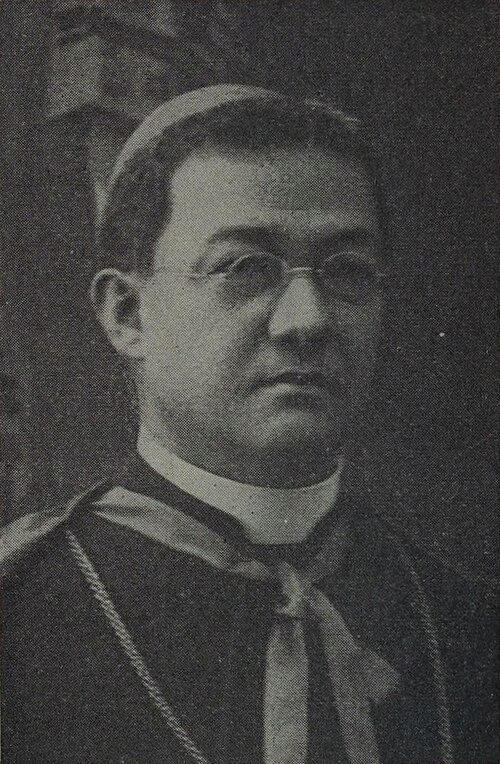Bishop Juan Bautista Gorordo, the first Cebuano to be elevated to the episcopacy, was born accidentalmente in Barili, Cebu, on April 18, 1862, His parents, Don Juan and Dona Telesfora Garces, were only temporarily living In Barili, Cebu, because Don Juan was commissioned by the Provincial Governor to visit the people in that side of the Province in order to collect wine-taxes. The Gorordo residence which has been preserved up to the present time is located on the corner of Hernan Cortes (now Lopez Jaena) and Ballesteros Streets in Cebu City. A book about the Gorordo Residence has been written by the historian n Resil Mojares in 1983 sponsored by Ramon Aboitiz Foundation entitled “Casa Gorordo in Cebu.”
At 12 years of age he entered the Seminario de San Carlos of Cebu and so distinguished himself as a student that even as a seminarian he was already made to teach Second Year Latin. He was ordained priest in March 31, 1885 by Bishop Madridejos and was appointed coadjutor in Opon and then later in San Nicolas. He wanted to join the Vincentian order but when he was already in Manila bound for Spain he got so sick that the doctors obliged him to return to Cebu. Back to the Seminary he taught Third Year Latin and served in the episcopal residence as assistant chaplain.
Bishop Alcocer appreciating the work of Father Gorordo made him on February 1, 1899 Secretary and Senior Notary of the Diocesan Chancery. In that capacity he helped administer the diocese during the revolutionary interim. When the Americans came he was one of those commissioned to discuss with the Americans the terms of surrender of the Cebuanos in order to save the city from bombardment.
Bishop Hendrick appointed him Vicar General of the Diocese. On October 17, 1907 Pius X raised him to the rank of a Domestic Prelate. When the Provincial Council of Manila was celebrated in December 1907 he was designated Secretary General (Notario Mayor) of the Council during which he delivered a sermon which was highly appreciated not only by the Bishops of the Council but also by the press in Manila.
When Bishop Hendrick was needing an Auxiliary on account of his failing health, the appointment was given to his “pinangga” Monsignor Gorordo who was designated Titular Bishop of Nilopolis and Auxiliary of Cebu on April 26, 1909. His consecration was considered the most grandiose and extended celebration lasting for a week featured with fireworks, games, serenatas and procession of carros alegoricos. Visitors came from different parts of the Archipelago. At the death of Bishop Hendrick he took possession of the diocese on July 2, 1910.
Bishop Gorordo governed for 21 years. He visited all the towns of Cebu and Bohol, confirming thousands of children, giving wise counsels to priests and faithful and helping the poor. His pastoral letters and circulars reflected his ardent love, apostolic zeal and great interest for the spread of the faith. He convoked the Second Diocesan Synod of Cebu on April 24-29, 1911 whose decrees merited the approval cum laude of the Holy Father, Pope Saint Pius X.
The Bishop maintained an intimate and confidential communication preference all the time charity over severity in his relationship with the clergy. At the end of clergy retreats he would preach to the priests about perseverance in their vocation taking ideas from the conferences and meditations. On Sundays in the afternoon he would almost without fail attend the Exposition of the Blessed Sacrament in the Cathedral.
Bishop Gorordo repaired many churches and built the Santo Rosario Girls’ Dormitory. At the price of 250,000 pesos, he constructed the magnificent building of the College of San Carlos (later transferred to and administered by the SVD Fathers as University of San Carlos). He had the church of Santo Rosario constructed which after the ravages of World War II became the Pro-Cathedral of Archbishop Julio Rosales. In Bishop Gorordo’s time arrived the Benedictine Sisters to whom he entrusted the St. Alphonsus Catholic School in Opon, the Sisters of the Holy Spirit in Tagbilaran, and the Belgian Sisters for St. Catherine’s School in Carcar.
At this time in the diocese Catholic associations were founded, such as “Ang Mga Anak sa Lungsod,” “Damas Catolicas,” the Knights of Columbus and the Conference of San Vicente de Paul. Bishop Gorordo was one of the founders of the newspaper “Ang Kamatuuran.” He also helped in the maintenance of “Boletin Catolico” and the prolongation of “Ang Atong Kabilin.” After natural calamities, like storms, earthquakes and fires, the Bishop would be the first to come in order to help the poor victims. One of Bishop Gorordo’s achievements was that he came out clearly and courageously against the “Legionarios del Trabajo” , an association which in his days was closely affiliated with Masonry.
He renounced the government of the Diocese in July 1931 on account of ill-health. He died in Cebu on December 20, 1934, His tomb can be found in the mausoleum which the late Cardinal Julio Rosales constructed in 1982.

